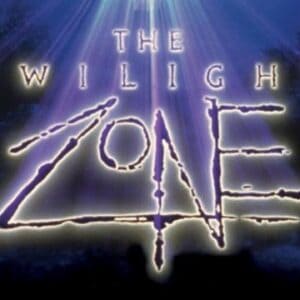Last Updated on July 23, 2021

Every New Year’s Eve we are blessed with a tradition as timeless as infinity: the Twilight Zone marathon. For me, and many others, it easily trumps getting dressed up to celebrate a ball’s ceremonious drop from a pole; New Year’s is all about another 48 hour barrage of television’s most intelligent and accomplished fantasy series. (Yes, I own the entire DVD set; yes, I’m still a slave to Syfy’s marathon.)
In honor of this tradition, I submit (for your approval) my top villains of the Twilight Zone. No twists, no lectures; just want to introduce you to the folks – and creatures – who brought their worst to some of the best episodes Rod Serling’s classic series had to offer.
WARNING: SOME EPISODE SPOILERS WITHIN!
SPECIAL MENTION: SATAN (“The Howling Man”, “Printer’s Devil”)

It wouldn’t be fair to talk about the Twilight Zone’s impressive catalogue of demons, cretins and straight-up sonsofbitches without giving a shout-out to that most beguiling baddie – the baddie, if you will – Satan himself. Beelzebub appeared in only two episodes, but cut quite a memorable figure in both instances:
In “The Howling Man”, Lucifer finds himself locked up by monks in a post-WWI castle. Doing what he does best, lying, he escapes, thanks in part to the acute idiocy of a stranded American traveler. No big deal, he only goes on to bring about war and pestilence for the rest of time…
In “Printer’s Devil”, the horned one comes in a most deceitful form: Burgess Meredith. Yes, Meredith, who played meek, sympathetic heroes in three previous Zones, gets to have fun here as a mischievous linotype operator for a failing newspaper who makes sensational news stories occur. And because it’s Meredith gleefully chewing the scenery – along with a crooked cigar – as a prankster Prince of Darkness who threatens the lives of young women and causes buildings to collapse, the Devil has never been more likable.
10. THE INVADERS (“The Invaders”; Season 2)

How can something so silly-looking be so menacing? The titular home-breakers from another galaxy are squat, bulky slowpokes who wield nothing more than buzzing flashlights. Plus, there’s only two of them. Nevertheless, the persistent buggers are everywhere at once – just ask Agnes Moorehead’s unnamed “Woman”, whose home is suddenly sieged upon by the abrasive explorers. Evidently seeking to do no more than torture the poor mute with their intimidating sparklers, the Invaders prove to be formidable foes despite their small, cumbersome frames. (It doesn’t hurt their cause that this episode is technically superb; the Twilight Zone crew at the top of their game, aided by a brilliantly freaky Jerry Goldsmith score.)
9. PETER CRAIG (“The Little People”; Season 3)

The Peter Craigs of the world often find themselves under the Twilight Zone’s microscope, and deservedly so. They’re petty, self-important creeps who demand respect, no matter how unearned. In “The Little People”, we make the ugly acquaintance of Mr. Craig, a louse who carries around a hefty chip on his shoulder, built there by a desire to be a bigger, more distinguished man than he actually is. (The dude hardly even seems grateful to be an astronaut, for f*ck’s sake.) Like most of the rotten folk who find themselves in the Zone, Craig’s shaky morals are put to the test in a most unusual way; in this case (wouldn’t you know it!) the test comes in the form of a tiny society of people that Craig discovers and is all too happy to exploit and dominate.
While it’s not exactly a remarkable episode (its “twist” ending can be seen a mile away) Joe Maross’ performance as the half-mad tin god makes “The Little People” a memorable viewing experience – and solidifies Peter Craig as one of the Twilight Zone’s most thoroughly hateful rat-bastards.
8. THE CHANCELLOR (“The Obsolete Man”; Season 2)

“You are obsolete!”
It’s hard to think of a more damning, disheartening accusation laid upon one’s feet, but that’s what The Chancellor does, and does with gusto. In an Orwellian future where the old, infirm and impractical are extinguished in an effort to weed out society’s expendable participants, The Chancellor’s job is to decree who lives and who dies, based on the person’s usefulness to the state. As ferociously played by Fritz Weaver, The Chancellor – who openly admires Hitler, even while ruing the dictator’s inability to wipe out more people (!) – is as megalomaniacal as he is irrational. But as a stand-in for all the governments and unnamed “states” which refuse to acknowledge the individuality of man and the gift of imagination, he’s also a most assertive, frightening and dangerous figure. (Plus he belittles poor old Burgess Meredith. That’s just not right…)
7. WILLIE (“The Dummy”; Season 3)

Here we have what’s long been one of my favorite episodes: “The Dummy” is a nightmarish sojourn into the tormented life of Jerry Etherson, alcoholic ventriloquist with a lot on his mind. What troubles Etherson (played by Cliff Robertson) more than anything is the fact that his popular act is being mucked with by the dummy, Willie, who is indeed alive and more than happy to give himself all the good material. Naturally it does no good to attempt explaining the dire situation to his manager, nor does it matter that Jerry’s failing to hold onto his marbles since Willie is such a good manipulator of the man’s sanity. Willie, the prototypical creepy doll, is completely in control and plans a hellish curtain-closer for poor Jerry.
“The Dummy” is practically flawless; from Serling’s dialogue (the somber conversations between Etherson and his manager are things of beauty), to the dread-fueled atmosphere as Etherson fights a losing battle, to a denouement that’s as horrifying as it is inexplicable. Willie and “The Dummy” will haunt your dreams forever, and you should be grateful for it.
6. THE GREMLIN (“Nightmare on 20,000 Feet”; Season 5)

In the case of “Nightmare at 20,000 Feet”, it’s certainly tempting to refer back to what I said about the Invaders: Here we have a villain which, when seen in plain sight, is more likely to inspire chuckles than chills; and yet, it’s the very stuff of fever dreams. And Richard Matheson, who penned this classic, sure can dredge up a fever dream like no other.
It’s not difficult to make William Shatner bug out; morphing his face into overblown expressions of shock, befuddlement and intense concern is the man’s medium. His fits of hysteria are really rather warranted here though, as his Robert Wilson’s fear of flying, combined with his close vicinity to the brink of a mental breakdown, are aggravated in a serious way by a curious gremlin that just wants to peek inside the wing of a plane. This fluffy bastard has his eye on some tantalizing wires and he’s going to play with them, no matter the cost (roughly hundreds of human lives). Furthermore, the gremlin really has Wilson’s number, floating away whenever others are called to look upon its deadly shenanigans. He may be silly – hell, he’s almost downright adorable – but this is one hitch-hiker you’d be lucky not to pick up.
5. THE NEIGHBORS (“The Monsters Are Due On Maple Street”; Season 1)

In his more forgiving moods, Rod Serling extolled the many virtuous traits of humanity: heroism, compassion, benevolence… More often, however, he noted that we’re inclined to be suspicious, fear-mongering brutes when confronted with anything out of the ordinary. The folks on Maple Street personify Serling’s worst instincts about mankind; our willingness to point a finger, shout an accusation and fear our neighbor will frequently trump any notion of coming together as a group. After all, a mob is easier to form in a time of crisis than a community. Though “The Monsters Are Due On Maple Street” is a clear comment on the Cold War paranoia and McCarthyism of the 50s, there’s no doubt that its pessimistic message resonates today.
4. THE KANAMITS (“To Serve Man”; Season 3)

Perhaps the greatest punchline in all of the Twilight Zone’s universe comes courtesy of the Kanamits – gawking, intergalactic 9-foot-tall meat lovers that enjoy ironic wordplay so much they serve it up on a silver platter. Imagine the arrogance of a race that practically begs us – by way of handing over their book of flesh recipes – to discover their plans for wiping us out via buffet table. Sort of prickish, no?
Not that it much matters; as our doomed representative of the human race says in “To Serve Man’s” melancholy final moments, sooner or later we’ll all of us be on the menu.
3. TALKY TINA (“Living Doll”; Season 5)

How good – or bad, if you prefer – is Talky Tina? She makes a scumbag like Erich Streator sympathetic. The genius of “Living Doll” is that our “hero” is a man we quite despise early on: Erich Streator (Telly Savalas, excellent) is a mean sonofabitch; resentful of his step-daughter, spiteful toward his wife and not at all a fan of the new doll they’ve brought home – partly because it probably cost a lot of money, mostly because it tells him it aims to kill him.
Thus begins a brief battle of wills between the desperate man and the laughing, taunting doll; our allegiance at first resides with anyone who is not Erich Streator, but as Tina becomes increasingly more sinister, mocking his attempts to do away with her, we’re surprised to find ourselves rooting for Erich to prevail, as his crusty exterior breaks away and a more vulnerable, frightened man is revealed.
It’s all for naught, as Streator learns the hard way: If you’re not nice to her, Talky Tina’s going to murder your ass.
2. GUNTHER LUTZE (“Deaths-Head Revisited”; Season 3)

Rod Serling was one of the notable purveyors of the sci-fi tale as metaphor. The Twilight Zone often used its fantasy settings as a means to delve into deeper truths about who we are and why we’re so f*cked up. (That’s a simplification, of course, but pretty accurate nonetheless.) Tales taking place in the future might as well be set in the past, and you never really need the signpost up ahead to illustrate that some of the series’ fantastical settings were substitutes for very real moments in our history.
But there’s no parable at play in “Deaths-Head Revisited”. In easily one of the show’s most daring and stunning entries, the monster is given a very human face: Gunther Lutze (played by Oscar Beregi), a “former” Nazi who callously returns to the concentration camp he once policed in a grotesque display of nostalgia. A retired torturer and murderer (in Serling’s brilliant words: “He was a black-uniformed, strutting animal whose function in life was to give pain”), Lutze revisits the scene of his crimes like a man fondly remembering a romance, all the while spouting the familiar “I did what I was ordered to do” line of bullshit.
Thankfully, the ghosts of Lutze’s past await him, as does a just, mind-crushing comeuppance. No Twilight Zone villain has ever received a more brutal and deserving finish.
1. ANTHONY FREMONT (“It’s a Good Life”; Season 3)

No contest. When it comes to the many fiends in the Twilight Zone’s plentiful rogue’s gallery, none tops young Anthony Fremont (Billy Mumy), the six-year-old maniac who controls his town with an evil petulance and a cherubic glare that’s liable to send you into a cornfield or turn you into a jack in the box. Yes, the little hellion has creative ways to do away with you, so you’d better not think bad thoughts about him or interrupt any of his favorite activities (listening to music, turning animals into godforsaken monstrosities, etc.); His brain has an itchy trigger finger.
The fact that the demented, bleak though darkly funny “It’s a Good Life” is arguably the Zone’s finest episode is made all the more surprising in that it doesn’t feature any of the series’ trademark twists or moral lessons; it’s just a straight-forward peek into the existence of a horrible monster and the helpless people he holds hostage. As Serling coldly says in the closing narration: “No comment here, no comment at all. We only wanted to introduce you to one of our very special citizens”.
Yowch! If this, and the list you’ve just traveled through, proves anything, it’s that the Twilight Zone can be a rather pitiless place. It’s any wonder we want to keep going back, again and again…




















Follow the JOBLO MOVIE NETWORK
Follow us on YOUTUBE
Follow ARROW IN THE HEAD
Follow AITH on YOUTUBE